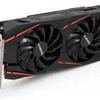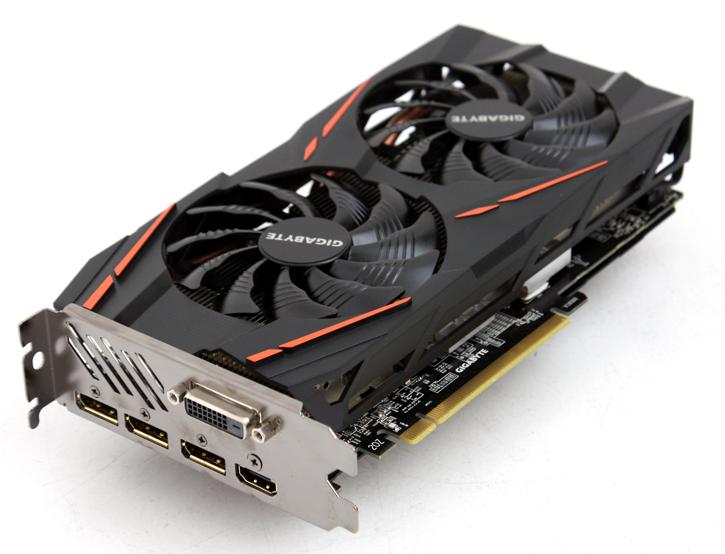Final words and conclusion
Final words and conclusion
I mentioned this in a couple of reviews already, but the Radeon RX 480 is a product series with a very nice appeal to it, however the reference product IMHO is a tad too noisy and runs hot. Next to that we all disliked the 6-pin power connector as it's just really close to the 150 Watt TDP. The board partners improved on everything the reference product did half-half. Gigabyte diverts all this with a proper design and build-quality graphics card. The G1 Gaming edition is fitted with a proper cooler that remains silent. It is also fitted with an 8-pin power connector, comes with a back-plate (no vents though) and is a notch tweaked out of the box as well. The end result is an impressive product series. Everything always comes down to price though, this 8GB version will cost you roughly 269/279 USD/Euro,
Aesthetics
When it comes to looks, this series come with the nice WindForce 2X cooler. This update also comes with a new RGB LED lighting control in the form of the top logo and fan (stopped) LEDs. You can switch on/off or to any color and animation you prefer, the choice is yours. That back-plate, I like it but it just has no openings at certain areas (GPU/VRM) for venting, this design is bound to trap heat. As you can see, I remain skeptical about back-plates, they can potentially trap heat and thus warm up the PCB. But the flip-side is that they do look better and can protect your PCB and components from damage. Consumer demand is always decisive, and you guys clearly like graphics cards with back-plates. In the end the result is a lovely looking product overall.
Performance
Performance wise you just cannot be anything other than thrilled about the Radeon RX 480. Now, the card is a bit all over the place; extremely fast in fill-rate limited games, a little less with GPU stringent ones but overall you are looking at a product that competes with the GeForce GTX 970 and sometimes even 980. What was baffling to see though is that this 8GB model is often spot on in performance with the Radeon R9 390 series and thus R9 290 series as well. And that actually might be a problem. See, many of you are already in the 390 or Fury series and, seen from that product perspective, the RX 480 will offer nothing new other than a few features. However, as we rewind that to where you are on a 280/280X/280 series graphics card, well, for 199 or 229 USD you are in for a treat in terms of performance and value. Let's not forget about other features; the Radeon RX 480 and Polaris 10 overall will offer proper performance, Eyefinity features and PCIe gen 3 compatibility and all the other stuff like HDMI 2.0b, DisplayPort 1.4 with HDR support and so on. The Radeon RX 480 series is a proper DirectX 12 product right from the get-go and has that little extra bite thanks to an increased number of shader processors (2304).
Who Would The Radeon RX 480 8GB Be Best Suited For?
As always, the answer to that question is a little complex. I would say that you'll need to look at your monitor and game preferences first and foremost. This card, at its given price range, makes quite a lot of sense right now for 1080P and 1440P. It is a very capable 2560x1440 resolution gaming graphics card and it obviously makes for a truly excellent 1080P card as well. Especially at that monitor resolution the card makes so much sense. But granted, at WQHD (2560x1440) most games run well enough. Another benefit is that at least the most elementary and arbitrary DirectX 12 Feature levels are supported in hardware. Even on very harsh-on-the-GPU titles you'll refrain from un-ticking graphics quality options to gain on framerate performance, there's very little trade-off to be made as the RX 480 will deliver enough. In short, for the money this is an excellent 1080P and a proper 1440P card that will often offer a nice 40~60 FPS experience at WQHD and proper image quality settings. It has plenty of muscle and has the graphics memory to deal with it, even with the best quality settings and some niche AA levels. Resolutions after 2560x1440 will be more complicated. Price to performance wise one should also take Crossfire into consideration. However, with multi-GPUs also comes 0-day driver issues with game releases. We'll test it at some point but two Radeon RX 480 cards set up in Crossfire might be a very sweet solution for Ultra HD gamers or the ones who like to go a little nasty with VSR and, of course, the latest gaming titles. Performance wise, most games will run seriously well at the very best image quality settings at 2560x1440. And sure, the cool factor remains that you get the advantages of an 8 GB framebuffer (if you opt for that model). With 8GB we feel the card is rather future proof as well.
Cooling and Noise levels
The G1 Gaming model comes factory tweaked at a notch over 1290 MHz. The temperature seems to hover at roughly 81 Degrees C under hefty full stress. That's warmer than expected and on par with the reference cooler. However, the best part is that it is a silent card. The cooler itself works really well, the card however does exhaust part of the warm air inside the PC. The card did not make any coil whine noises.
Power Consumption
The board is rated by us at roughly 160~170 Watts TDP, that means when you completely stress it, that's the power consumption. Our measurements showed that the board TDP is indeed roughly in that Wattage region, we measured a little higher but with some games also noticed lower wattages. The move to 14nm FiNFET obviously is testimony to a great perf/watt ratio. We feel that at this level the card is consuming very reasonable amounts of power for this kind of performance. No complaints here really.
Overclocking
The card in default mode is running 1290 MHz and that unfortunately means there isn't a lot of room left for tweaking. Overclocking wise we could get the card stable at ~1375 MHz. We tried 1405 MHz and while it's booting and working for a while, it does not remain stable enough. So 1375 MHz seems to be the max. The memory will reach anywhere from 8.8~9.0 Gbps (for the 8 GB model). Overall these are satisfying results. With a default temperature profile the card will remain to be silent and at the very same temperature levels as default. But keep in mind, increase power boost to 50%, here's where you'll get the most gain in extra performance.
Final Words
We've tested a good number of RX 480 cards by now, and yeah I do like them. The nature of the best is that they offer great performance, though run a bit hot. The G1 Gaming edition is testimony to exactly that as under full load we reach the 80 Degrees C marker, and that is a little higher than we are all used to these days. 80 Degrees C is fine though, especially since you won't hear the cooler. The card looks lovely, and yeah, i think i already stated enough about the back-plate... but Gigabyte, please put vents on that back-plate as the rear side components do need a little airflow. Props for the inclusion of a DVI connector. Anyone looking for an affordable upgrade to a WQHD capable graphics card coming from say a 280/380... well, this card series will offer killah value for money. 279 USD for this version is merely a tenner or two over reference and that makes this a mainstream product. Other than that, the Radeon RX 480 8GB is obviously a little gem for the serious gamer with a proper monitor as it just oozes value. In the end the G1 Gaming is a proper Full HD and even WQHD gaming graphics cards with the right boxes ticked. Highly recommended if you have a nice mid-range graphics card in your purchasing shortlist. We do hope that the price will come down a bit more though, 250 USD would be a terrific spot for an 8GB version.
Recommended Downloads
- Sign up to receive a notice when we publish a new article
- Or go back to Guru3D's front page



